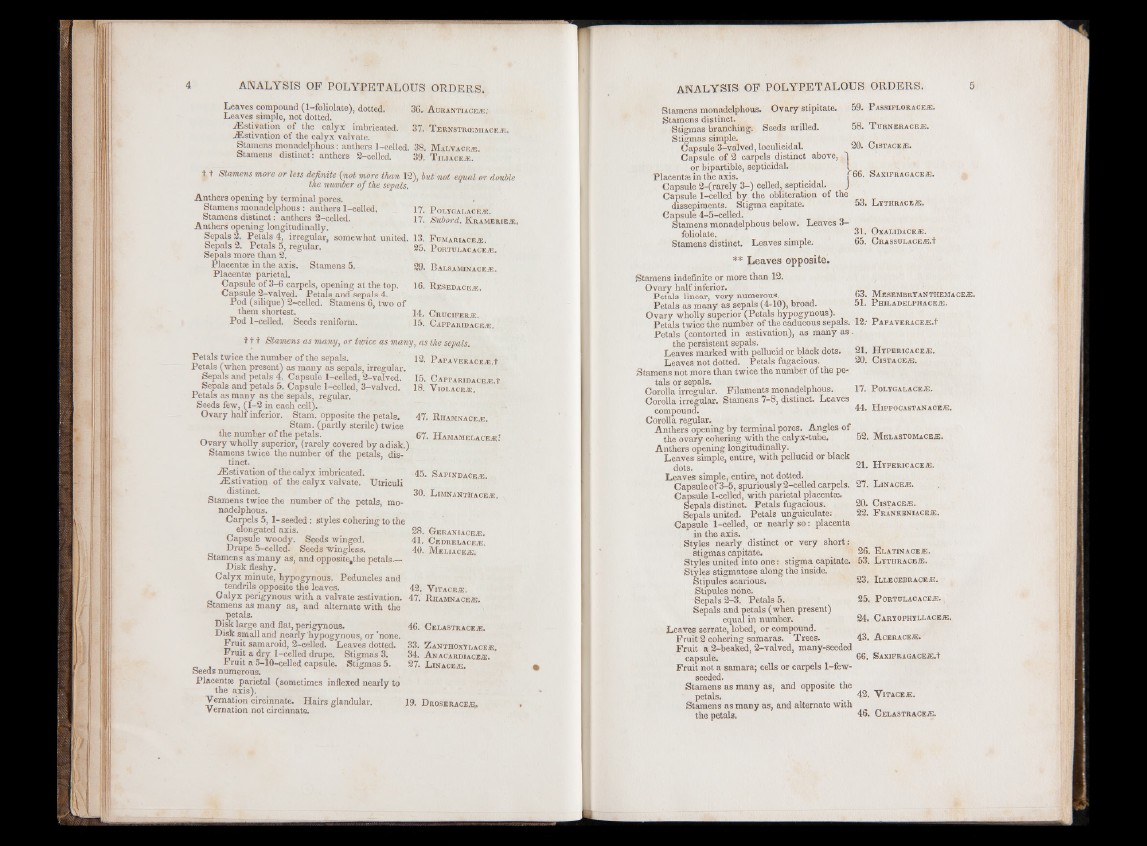
Leaves compound (1-foliolate), dotted. 36. Aurantiage®;
Leaves simple, not dotted.
./Estivation of the calyx imbricated. 37. T ernstrcemiace/e.
./Estivation of the calyx valvate.
Stamens monadelphous: anthers 1-celled. 38. Malvace®
Stamens distinct: anthers 2-celled. 39. T iliace®.
11 Stamens more or less definite (not more than 12), but not equal or double
the number of the sepals.
Anthers opening by terminal pores.
Stamens monadelphous: anthers 1-celled,
Stamens distinct: anthers 2-celled.
Anthers opening longitudinally.
Sepals 2. Petals 4, irregular, somewhat united.
Sepals 2. Petals 5, regular,
Sepals more than 2.
Placentae in the axis. Stamens 5.
Placentae parietal.
Capsule of 3-6 carpels, opening at the top.
Capsule 2-valved. Petals and Sepals 4.
Pod (silique) 2-celled. Stamens 6, two of
them shortest.
Pod 1-celled. Seeds reniform.
17. POLYQALACÉÆ.
17. Subord. Kramerie®.
13. F umariace®.
25. PoRTULÀCACEÆ.
29. Balsaminaqe®.
16. Resedaceæ.
14. Crucifer®.
15. Capparidaceæ.
111 Stamens as many, or twice as many, as the sepals.
Petals twice the number of the sepals.
Petals (when present) as many as sepals, irregular.
Sepals and petals 4. Capsule 1-celled, 2-valved.
Sepals and petals 5. Capsule 1-celled, 3-valved.
Petals as many as the sepals, regular.
Seeds few, (1-2 in each cell).
Ovary half inferior. Stam. opposite the petals.
Stum. (partly sterile) twice
the number of the petals.
Ovary wholly superior, (rarely covered by a disk.)
Stamens twice the number of the petals, distinct.
A3sti vation of the calyx imbricated.
Aestivation of the calyx valvate. Utriculi
distinct.
Stamens twice the number of the petals, monadelphous.
Carpels 5, 1-seeded: styles cohering to the
elongated axis.
Capsule woody. Seeds winged.
Drupe 5-celled. Seeds wingless.
Stamens as'many as, and opposite,the petals_
Disk fleshy.
Calyx minute, hypogynous. Peduncles and
tendrils opposite the leaves. y ita(Je® .
Calyx perigynous with a valvate aestivation. 47. Ri-iamnace®.
Stamens as many as, and alternate with the
petals.
Disk large and flat, perigynous.
Disk small and nearly hypogynous, or 'none.
Fruit samaroid, 2-celled. Leaves dotted.
Fruit a dry 1—celled drupe. Stigmas 3.
Fruit a 5-10-celled capsule. Stigmas 5.
Seeds numerous.
Placentae parietal (sometimes indexed nearly to
the axis).
Vernation circinnate. Hairs glandular.
Vernation not circinnate.
12. PAPAVERACEÆ.t
15. C APPARIDACEÆ.t
18. VIOLACEÆ,
47. Rhamnace®.
67. H amamelace®;
45. Sapindaceæ.
30. L imnanthace®.
28. Geraniace®.
41. Cedreeace®.
40. Meliace®.
42. VlTACE®.
46. Celastraceæ.
33. Z antiioxyraceæ,
34. Anacardiace/e.
27. L inaceæ.
19. Dp.oseraceæ,
Stamens monadelphous. Ovary stipitate. 59. P assifloraceæ.
Stamens distinct. m .
Stigmas branching. Seeds arilled. 58. T urnerace®.
Stigmas simple.
Capsule 3-valved, loculicidal. 20. Cistaceæ.
Capsule of 2 carpels distinct above, "1
or bipartible, septicidal. i
Placentae in the axis. i "6. Saxifragace®.
Capsule 2-(rarely 3-) celled, septicidal. J
Capsule 1—celled by. the obliteration of the
dissepiments. Stigma capitate. 53. Lythrace®.
Capsule 4-5-celled.
Stamens monadelphous below. Leaves 3-
foliolate. 31. Oxalidace®.
Stamens distinct. Leaves simple. 65. Crassulace®.1-
** Leaves opposite.
Stamens indefinite or more than 12.
Ovary half inferior. „
Petals linear, very numerous. 63. JVLesembryanthemace®.
Petals as many as sepals (4-10), broad. 51. P hiladelphace®.
Ovary wholly superior (Petals hypogynous).
Petals twice the number of the caducous sepals. 12; Pa p a VERACEi s . t
Petals (contorted in estivation), as many a s.
the persistent sepals.
Leaves marked with pellucid or black dots. 21. H ypericace®.
Leaves not dotted. Petals fugacious. 20. Cistace®.
Stamens not more than twice the number of the petals
or sepals. „
Corolla irregular. Filaments monadelphous. 17. P olygalace®.
Corolla irregular. Stamens 7-8, distinct. Leaves
compound. 44- H ippocastanace®.
Corolla regular.
Anthers opening by terminal pores. Angles of
the ovary cohering with the calyx-tube. 52. Melastomace®.
Anthers opening longitudinally.
Leaves simple, entire, with pellucid or black
d0ts. 21. H ypericace®.
Leaves simple, entire, not dotted.
Capsule of 3-5, spuriously 2-celled carpels. 27. L inage®.
Capsule 1-celled, with parietal placentae.
Sepals distinct. Petals fugacious. 20. Cistace®.
Sepals united. Petals unguiculate: 22. F rankbniace®.
Capsule 1-celled, or nearly so: placenta
in the axis.
Styles nearly distinct or very short:
stigmas capitate. 26. Elatinaoe®.
Styles united into one: stigma capitate. 53. L ythrace®.
Styles stigmatose along the inside.
Stipules scarious. 23. Illecebrace®.
Stipules none.
Sepals 2-3. Petals 5. 25. P o r tu la c a c e®. ,
Sepals and petals (when present)
equal in number. 24. Caryophyllace®.
Leaves serrate, lobed, or compound.
Fruit 2 cohering samaras. Trees. 43. Acerace®.
Fruit a 2-beaked, 2-valved, mahy-seeded
capsule. 66. Saxifragace®,4
Fruit not a samara; cells or carpels 1-few-
seeded.
Stamens as many as, and opposite the
petals. . 42. V itace®.
Stamens as many as, and alternate with
the petals. 46. Celastrace®.